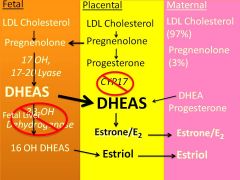![]()
![]()
![]()
Use LEFT and RIGHT arrow keys to navigate between flashcards;
Use UP and DOWN arrow keys to flip the card;
H to show hint;
A reads text to speech;
15 Cards in this Set
- Front
- Back
|
These embryonic cells produce hormones during pregnancy.
IS THIS FC NECESSARY? |
Cytrotrophoblast and
Syncitiotrophoblast: Direct contact w/maternal blood in intervillous space; preferentially secreted into mother Makes protein hormones (hCG) |
|
|
hCG subunits and homology.
|
HCG:
Alpha subunit: homologous to FSH, LH, TSH Beta subunit: specific to HCG, but similar to LH Detectable at 6 days post implantation (before missed menses) |
|
|
hCG function
Diagnostic Utility (Syndrome Specific) |
Critical for maintenance of corpus luteum (PG production to maintain endometrium)
Later stimulates T secretion by fetal testes Weak thyrotrophic activity Higher in Trisomy 13/21, and lower in trisomy 18 |
|
|
Human Placental Lactogen:
AKA When is it produced? Produced by? |
Human Chorionic Somatomammotropin (HCS)
Produced day 18 of pregnancy (not essential for normal pregnancy!) Produced by syncytriotrophoblast |
|
|
HPL Function
|
Increases insulin levels (diabetogenic)
Stimulates IGF-1 production, induces insulin resistance Enhances lipolysis (critical in fasting state) |
|
|
hCG levels vs hPL levels
|
hCG rises very rapidly, peaking at 10 weeks from LMP
hPL begins to rise around 6 weeks, and increases exponentially, peaking at birth |
|
|
Effect of food intake on hPL.
|
Food intake will increase glucose levels and cause a decrease in hPL; thus, decreased lipolysis/FFA's
Note: glucose passes readily from maternal compartment to placental compartment to fetal compartment |
|
|
Effect of fasting state (sleep) on hPL.
|
Inc'd hPL-->inc'd lipolysis and FFA
Ketones increase and readily pass into fetus |
|
|
Describe sources of progesterone production throughout pregnancy.
|
For first 7-10 weeks from LMP, corpus luteum produces PG to maintain endometrium
Marked increase in placental PG from 6 weeks to term 17OH PG rises early (ovarian origin), but returns to baseline by 10 weeks (only need corpus luteum for first 10 weeks!) |
|
|
Progesterone function.
|
Uterine relaxation
Prepared endometrium for implantation Breast glandular dev't Suppresses maternal immune response Substrate for production of fetal steroids (GC's, MC's)--fetus can't make PG! |
|
|
Describe progesterone synthesis and transfer in the maternal, placental, and fetal compartments.
|
Maternal: LDL Cholesterol and Pregneneolone both enter Placental Compartment
Placental: LDL-->Pregnelenon-->Progesterone (PG can then go to mom or baby); can't go any further bc lacks 17-alpha hydroxylase CYP17 Fetal: LDL Cholesterol-->Prenenolone; can't go any further bc lacks 2-beta OH dehydrogenase Pregnenolone can re-enter placenta |
|
|
Estrogens:
Precursors Sources |
Androgen is estrogen precursor
Ovary and extra ovarian sites: E1, E2 Placenta produces E3 (E1 and E2 to a lesser extent) |
|
|
Describe progesterone synthesis and transfer in the maternal, placental, and fetal compartments.
|

|
|
|
Estrogen function
|
Physiologic changes of pregnancy
Breast preparation for lactation Cervical ripening--preparation for labor |
|
|
Placental sulfatase:
Function Result of Deficiency |
Enzyme required to produce estrogen in placenta
Deficiency results in failure to have cervical ripening; failure to go into labor (post dates pregnancy)--x-linked recessive dz seen in males, assocd postnatally with ichthyosis (severe cracked skin ) |

